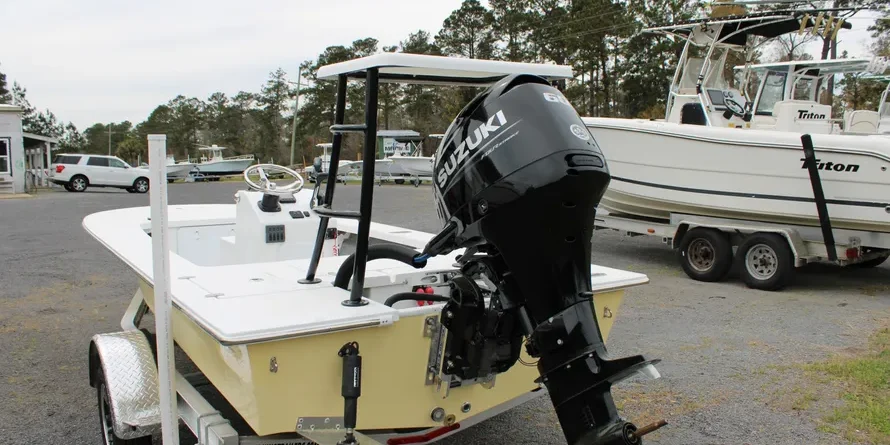At Cape Romain Marine in McClellanville, SC, we know how much you rely on your Suzuki outboard motor for performance, reliability, and peace of mind on the water. Whether you’re cruising the waters around Charleston or fishing along the Lowcountry coast, keeping your Suzuki engine well-maintained is critical to maximizing its lifespan and performance.
Below, we’ve outlined key maintenance tips every Suzuki outboard motor owner should follow to keep their engine running smoothly season after season.
1. Follow the Manufacturer’s Service Schedule
One of the most important aspects of Suzuki outboard maintenance is adhering to the manufacturer’s recommended service intervals. Suzuki provides a detailed service schedule in the owner’s manual that includes oil changes, filter replacements, gearcase service, and inspections. Typical service intervals include:
- First 20 hours: Break-in inspection
- Every 100 hours: Regular maintenance service
- Annually: Comprehensive inspection and tune-up
Missing or delaying these services can lead to premature wear and costly repairs. If you’re unsure where your engine stands, schedule a check-up with our certified marine technicians at Cape Romain Marine.
2. Change the Engine Oil and Filter Regularly
Oil is the lifeblood of your Suzuki outboard engine. Dirty or low oil can cause internal damage and reduce engine performance. For four-stroke models, change the engine oil and oil filter every 100 hours or at least once a year. Use only Suzuki-approved marine-grade oil to ensure optimal lubrication and engine protection.
Pro tip: Always warm up the engine before draining the oil. This helps the old oil flow out more easily and completely.
3. Inspect and Replace the Water Pump Impeller
The water pump impeller is responsible for cooling your engine by circulating water through the cooling system. Over time, the impeller can wear out or become damaged, leading to overheating and potential engine failure. We recommend inspecting the impeller every 100 hours and replacing it every 200 hours or every two years, whichever comes first.
Signs of a failing impeller include high engine temperature, reduced water flow from the telltale (pee) stream, or steam in the exhaust.
4. Flush the Engine After Every Use
Saltwater is highly corrosive. To prevent salt buildup, corrosion, and clogging of cooling passages, always flush your Suzuki outboard motor with fresh water after every use—even if it’s only been in the water for a short time.
Most Suzuki outboards have a freshwater flush port that allows you to connect a hose without running the engine. Flush for 5–10 minutes, then let the water drain completely.
5. Check and Replace the Spark Plugs
Spark plugs play a critical role in engine performance and fuel efficiency. Over time, they become fouled or worn, leading to hard starts, misfires, and poor fuel economy. Inspect spark plugs at every 100-hour service and replace them as needed. Always use the recommended spark plugs for your specific Suzuki model.
6. Maintain the Lower Unit (Gearcase)
The lower unit houses the gears that transfer power from the engine to the propeller. Every 100 hours, drain and replace the gear oil to ensure proper lubrication. When changing the oil, inspect it for water intrusion (milky oil) or metal shavings, which could indicate internal wear or seal failure.
It’s also a good idea to inspect the propeller for dings or fishing line wrapped around the shaft. Damage to the propeller or seals can shorten the life of your gearcase.
7. Keep the Fuel System Clean
Fuel-related issues are a common cause of poor engine performance. Use a quality fuel stabilizer—especially if you use ethanol-blended fuel—and never let fuel sit in the tank for more than a few months without treatment.
Replace the inline fuel filter every 100 hours or annually. Also inspect fuel lines, primer bulbs, and connectors for cracks, wear, or signs of leaks.
8. Inspect the Battery and Electrical Connections
A weak or corroded battery can leave you stranded. Check the battery terminals for corrosion and clean them with a wire brush if needed. Ensure all electrical connections are tight and protected from moisture. If your Suzuki outboard has an electric start, test the battery’s charge regularly and replace it every few years.
9. Store Your Engine Properly During the Offseason
If your boat will be out of the water for an extended period, such as during the winter months, proper storage is essential. Follow these offseason tips:
- Fog the engine to protect internal components
- Drain and replace lower unit oil
- Disconnect the battery and store it in a cool, dry place
- Use a fuel stabilizer and fill the tank to prevent condensation
Consider having Cape Romain Marine perform a full winterization service to ensure your Suzuki outboard is protected while in storage.
10. Trust Professional Service When Needed
While many maintenance tasks can be performed by knowledgeable boat owners, some repairs and diagnostics are best left to the professionals. At Cape Romain Marine, our certified Suzuki technicians have the tools, parts, and expertise to keep your outboard running at peak performance.
We offer full-service maintenance, warranty repairs, and engine repowers at our McClellanville location, serving boaters from Charleston to Georgetown and everywhere in between.
Schedule Your Suzuki Outboard Service Today
Routine maintenance is the key to getting the most from your Suzuki outboard motor. Whether you’re due for a 100-hour service or need help diagnosing an issue, Cape Romain Marine is here to help.
Call us today or visit caperomainmarine.com to schedule your outboard service or learn more about our repower and maintenance packages.
Your engine deserves the best. Trust Cape Romain Marine—your authorized Suzuki Outboard service center in McClellanville, SC.






